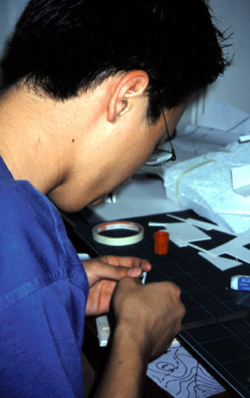 Online
Edition
Online
Edition | From
the editor Letters to the editor Milestone Answerman Campus Life Periscope Social Issues People Photo Features Education Channel Culture & Leisure Science |
| Last
Issue Archive |
| About
Varsity Advertise Media Links CUHK homepage JLM homepage |
Related
Links
The
Computer Science and Engineering Department of CUHK
Department of Architecture of CUHK
Life
in busy departments
Too much work,
too
little time
By Timothy Ser
Some
departments at universities are known for their overwhelming workloads.
The
Department of Architecture and the Department of Computer Science and
Engineering at The Chinese University of Hong Kong are two of them.
Patrick
Wong (not his real name) is a Year 1 architecture student at The Chinese
University of Hong Kong.
As
for his heavy workload, he said he had no special feelings about it.
During
his interview with Varsity, Wong was working on a design in a studio. In
fact, he had a fever that day.
But
he said it was normal, as he could not get enough sleep.
Excluding
working hours at home, Wong said he worked for an average of 10 hours per
day in the studio.
“I
just get used to it,” said he.
He
had 34 lessons each week, and he could not but accept such hectic
schedule.
“The
department assigned the tight schedule to me,” said Wong, “I have no
choice.”
A
typical example was that there were 11 lessons per week for a 3-credit
major course.
Wong
has nearly no leisure time and he works in the studio when he is free.
“I
am very interested in architecture,” said Wong. That is why he can
survive the tiresome work.
He
has fun in the studio. He likes chatting with his classmates.
Justin
Leung is another student who is overloaded with his assignments.
“I
am completely exhausted!” exclaimed Leung, a Year 2 student in the
Department of Computer Science and Engineering.
Leung
has 29 lessons per week, and he spends most of his time in the computer
laboratory.
“I
did an assignment in the laboratory for 50 hours within 4 days last
week,” said he.
Leung
said that in his “peak hours” he was required to complete one
assignment per day.
He
got prepared for the gruelling schedule after deciding to study computer
science.
But
it was still beyond his expectations that the department would be so
demanding.
He
said the department should provide supplementary courses for students who
were weak in foundations.
He
said that such courses are necessary for those who have not taken applied
mathematics in secondary schools, as he did.
Said
Leung: “The professor will just ask you to complete an assignment
without teaching you anything.
“Sometimes,
the tutor does not know how to run the computer programme either.”
Leung
finds no alternative other than self-studying, which has made him spend
even more time working the end.
However,
Leung is satisfied with his work.
“This
is because I started from nothing,” said Leung.
However,
the two department heads held very different views toward the workload.
Chairperson
of the Department of Architecture, Prof. Essy Baniassad, came to the
University in August 2000.
He
said that all architecture students had heavy workload, but their
students’ workload was not too heavy compared with that of other
schools.
According
to Prof. Baniassad, he often works with students in studio.
“I
find them enjoying their work,” said Prof. Baniassad.
Similarly,
Chairperson of Department of Computer Science and Engineering, Prof. Leung
Kwong Sak, said that heavy workload is indispensable.
Prof.
Leung said they did not just train students simply to be programmers.
“We
are responsible for training fully equipped professionals, since they will
become leaders in information technology,” said he.
Prof.
Leung welcomed all comments from students about tight schedules or heavy
workloads.
“My
door is open,” said he.![]()
|
Timothy
Ser
 Hectic schedules suffocate students. |